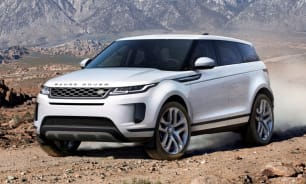The Evoque has always been a car all about its sleek, city-slicking design, an iconic piece of modern SUV art from Jaguar Land Rover head of design, Gerry McGovern.
With its shapely proportions, clever descending roofline, and a silhouette which successfully reflects a miniaturised version of the Range Rover, the Evoque is at once classy with a faint suggestion of toughness under the skin.
The blacked-out grille, slimline headlights, and contemporary strip across the tailgate all serve to add intrigue to this SUV, and the extra detailing in the front bumper, shapeliness of the bonnet, and contrast black trims (with extra contrast panels on our test car matching the gloss black wheels) serving to add to its premium appeal.
It’s important to remember, while the Evoque slides into a busy small SUV landscape now, it was one of the first to make a premium car so successfully appealing in this small SUV space way back in 2011 with the first Evoque, following Land Rover’s historic trend of being in front of the SUV curve.
Rival small SUV designs may have caught up in the minds of many with the likes of the Audi Q3, BMW X2, and Volvo XC40 shining in recent years, but few have won as many design accolades as the Evoque.
Range Rover seems to be leaning into a more upper luxury trend, not just with the pricing, but with the vibe of the car’s interiors, too.
The new generation Evoque, for example, took a big jump in the look and feel of its interior appointments when it launched in 2019, and over time has only consolidated its market positioning.
The HSE grade which our P300e hybrid arrives in is lavish on the inside, with lovely suede-like seats, intricate contrasting grey cloth trims in the doors (do I detect an influence from Volvo here?) and a plush-looking dash, all finished in soft-to-the touch materials.
Attention to detail, like the silver bezels which adorn the centre console and media screen, add to the premium flair which lifts the Range Rover badge above the Land Rover one, and I do like the way the additional function screen seamlessly melts into the piano finish and integrated dials. While it’s always a nightmare to keep gloss piano finishes clean, it looks oh-so primo.
It’s a little odd the P300e has analogue dials, which seems to miss the premium edge which a fully digital dash might provide although the 7.0-inch centre dash screen has a great resolution and speed, as well as a mostly well laid out operating system.
I found the R-Dynamic modes, which can sharpen up the accelerator response and steering buried two menus deep, unnecessarily hard to find, as were various EV information screens and other less important functions.






















.png)
















